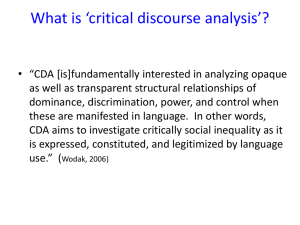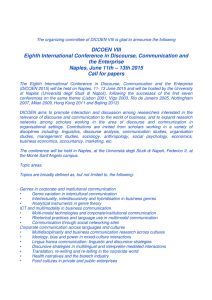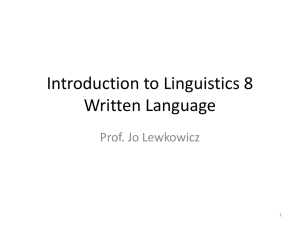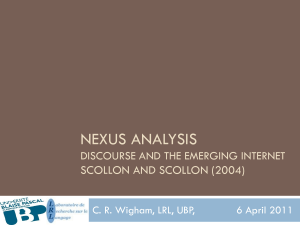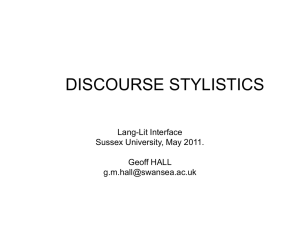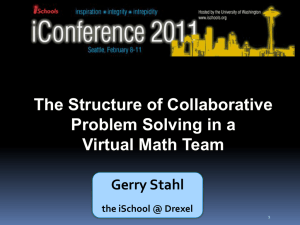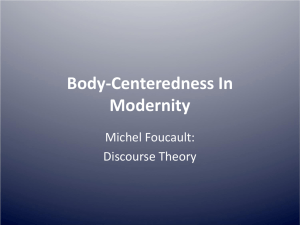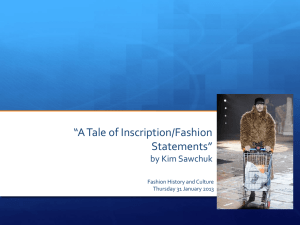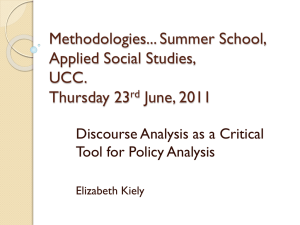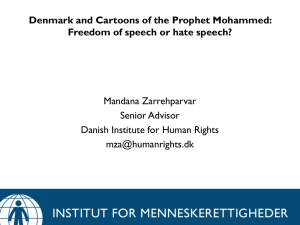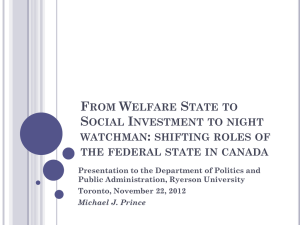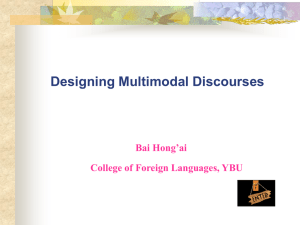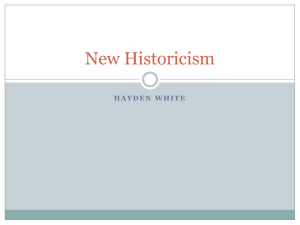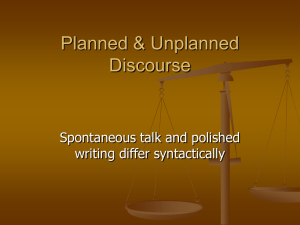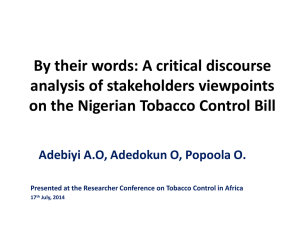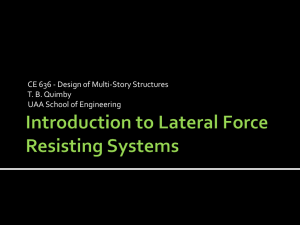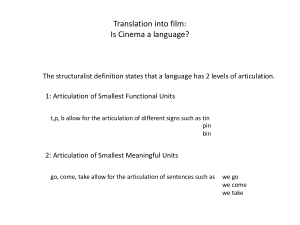Discourse- and frame analysis
advertisement
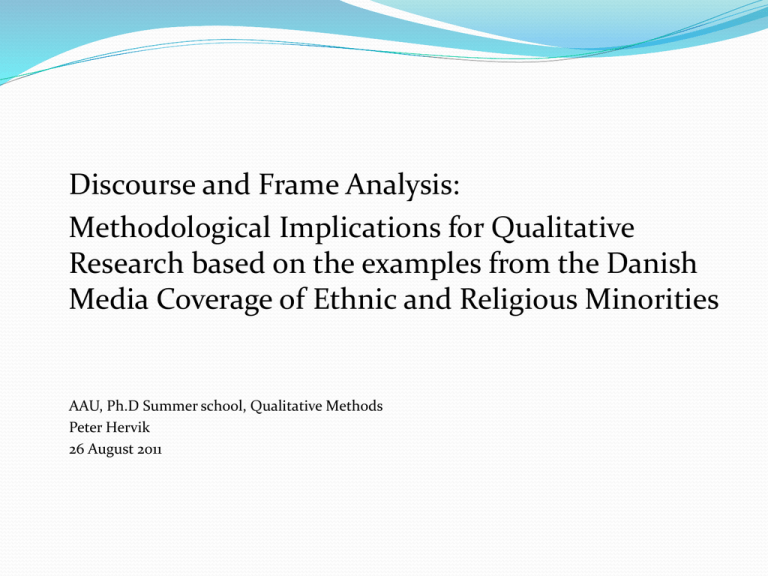
Discourse and Frame Analysis: Methodological Implications for Qualitative Research based on the examples from the Danish Media Coverage of Ethnic and Religious Minorities AAU, Ph.D Summer school, Qualitative Methods Peter Hervik 26 August 2011 Traditional ethnographic fieldwork Bronislaw Malinowski 1884-1942 Franz Boas 1858 - 1942 Some features Unique for anthropology/ethnography – participant observation Learn and record change First in non-European societies Take part in local life as much as possible Becoming marginal to own and new societies Translation as a key metaphor Earlier: economics, politics, kinship, religion, material culture Now: locality as an issue; spheres of social life; identity; agency Social practice theory The practices and discourses that people engage in and embody, and a focus on the actual ways people produce these practices and discourses within sociocultural constraints which themselves are subject to reproduction and change through such human activities what goes in and through the actor’s engagement in practice yet constrained by experience and discourse Imposed vs. embodied Imposed discourses Embodied knowledge The imposed vs. the embodied Constructivism vs. Culturalism Circuit of cultural production Framing is • Framing is used to describe the manner in which we as human beings package messages in order to bring about a particular interpretation in the receiver • Frames are the discursive cues, consciously or not, used to evoke, or align, its message with certain preexisting understandings Robert Entman (1993) To frame is to select some aspects of a perceived reality and make them more salient in a communicating text, in such a way as to promote a particular problem definition, causal interpretation, moral evaluation, and/or treatment recommendation for the item described (p 52) Frame building & frame setting; media & audience frames • Frame building refers to the cause and construction of frames, while frame setting is the effect of frames. There is no casual relation • Frames have at least four locations in the communication process; the communicator, the text, the receiver, and the culture • Communicators make framing judgments. • Text contains frames. • Receivers may be guided by other frames as well. • Culture is the stock of commonly invoked frames, or knowledge. Three generic (not archetypal) frames Generic means relating to or descriptive of an entire group or class; general. 1) THE CONFLICT FRAME 2) The ECONOMIC CONSEQUENCES frame 3) HUMAN INTERESTS frame Jack Lule’s masternarratives 1) The victim. 2) The scapegoat. 3) The hero. 4) The good mother. 5) The trickster. 6) The other world. 7) The flood. Typically frames define problems, diagnose, evaluate and prescribe 1) Frames define problems – determine what a causal agent is doing with the costs and benefits are, usually measured in terms of common cultural values. 2) Diagnose causes – identity the forces creating the problem. 3) Make moral judgments – evaluate causal agents and their effects. 4) Suggest remedies – offer and typify treatments for the problems and predict their likely effects. What is the problem? Who created the problem? What actors are presented in what roles? Who are the good ones, who are the bad ones? What can be done? What is the language of the frame?—what wording is used to create it? Figure 1. The three frames – a struggle of news and views Frames Freedom of Speech as a Danish Freedom Freedom of speech; A universal human right threatened by Islamism Demonization of Muslims and political spin is the issue; not freedom of speech What is the problem? Islam, Islamism, the dark and uncivilized Middle East Islamism with a lack of human rights such as freedom of speech Demonization of Muslims in Denmark and political spin, not freedom of speech Who created the problem? Islamic rulers and the Danish Imams Islamists in the Middle East Jyllands-Posten, the Government and the Danish People’s Party What actors are presented in what roles; who are the good ones, who are the bad ones? The Danish “we” are the good ones defending freedom of speech, the ones limiting the freedom in any way are the bad ones. “We” in the “West” are the good ones; “the rulers in the Middle East” are the bad ones. There exists no “we” in this framing, it is rather “moral” who is put in this position, whereas Jyllands-Posten, the Government and the Danish People’s Party are the bad ones. What can be done? Fight, be provocative and stand firm in the fight for freedom of speech. We” can fight the fight for the oppressed populations in the Middle East The solution is dialogue and co-existence. What is the language of the frame? A language characterized by dichotomized terms: “us” and “them”, a “black and white” world perspective Orientalist language Didactic, aggressive, frustrated. The spin detector Who is coming out with the message? Several places at the same time? Is there a campaign with several steps? What is the occasion? (purpose). What is the timing? Why right now? Relate to other events AND news stream. Where is the message coming out? (locality) Why this situation to say precisely this? Which media is chosen? Is it an original story? What function does it have? (legitimacy) What is said? Why precisely this? Goes with timing and who the communicator is. Is it a ‘planted story’? Who is to gain and loose? How is the message formulated? (Choice of words, strategy) Who is the target group? Jyllands-Posten, 30 October 2005, interview with the prime minister Sunday Initiated by the prime minister Government friendly newspaper No critical questions After criticism in the mass media Berlingske Tidende, 26 February 2006, interview with the prime minister Sunday Initiated by prime minister Government friendly newspaper No critical questions After the cartoon crisis has peaked Discourse analysis Discourses or rather the discursive impositions, the attempt to convey, persuade, control, discipline Signs are vehicles for thought that also and simultaneously serve as tools for persuasion and manipulation, for commanding and coordinating actions, for kindling and expressing emotions, and for maintaining social relations Discourses are .. “Practices which form the objects of which they speak” (Foucault 1972:49. “Objects and events come into existence for us as meaningful entities through their representation in discourse. This is what is meant by the claim “there is nothing outside the text.” A discourse refers to a set of meanings, metaphors, representations, images, stories, statements and so ont hat in some way together produce a particular version of events. It refers to a particular picture that is pained of an event, person or class of persons, a particular way of representing int in a certain light.” (Stuart Hall in V. Burr 1995 page 67) Spoken words are sign vehicles that have a public life Examples Discourse of Culturalism Discourse of Nationalism Discourse of Neo-Racism Discourse of Anti-establishment Anti-migrant Discourse Anti-elite Discourse Critical discourse analysis Ruth Wodak Norman Fairclough Teun van Dijk Fairclough Three-dimensional conception of discourse TEXT – words with specific meanings (talk, writing, photographs or other) DISCURSIVE PRACTICE – production, distribution and consumption of texts SOCIAL PRACTICE – the relationship to ideology and power Fairclough and Wodak 1) CDA addresses social problems 2) Power relations are discursive 3) Discourse constitutes society and culture 4) Discourse does ideological work 5) Discourse is historical 6) The link between text and society is mediated 7) Discourse analysis is interpretative and explanatory 8) Discourse is a form of social action Ruth Wodak 1) How are persons named and referred to linguistically? 2) What traits, characteristics, qualities and features and attributed to them? 3) By means of what arguments and argumentation schemes do specific persons or social groups try to justify and legitimized the exclusion, discrimination, suppression and exploitation of others? 4) From what perspective or point of view are these labels, attributions and arguments expressed? 5) Are the respective utterances articulated overtly? Are they intensified or are they mitigated 72-73 Fairclough: Look for: DOMINANCE, DIFFERENCE AND RESISTANCE Teun van Dijk CDA starts with a prevailing social problem, then chooses its perspective of those who suffer most, critically analyses those in power, those who are responsibility and those who have the means and the opportunity to solve such problems Frontpage of Jyllands-Posten 11 September 2005 “Islam is the most belligerent” A phenomenon cannot be reduced to its economic or psychological aspects, but are always linked to something else. It must always also be understood from the perspective of how relevant actors make sense of it Follows the principle that all societies, cultures and even persons must be understood first on their own terms. Only then can you move on to compare and generalize Relativism is the only road to generalization Ask always analytically: What is unique and what is shared Four ideals of ethnography and anthropology 1) Holistic analysis 2) Contextual analysis, historicize 3) Comparative analysis 4) Relativistic analysis Emic & Etic Phonemics, the sound system Intrinsic phonological distinctions that are meaningful to speakers Phonetics, phonetic analysis Extrinsic concepts that are meaningful to the linguists
